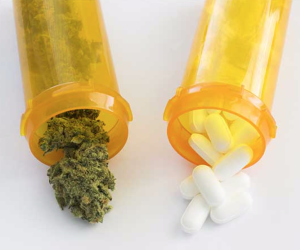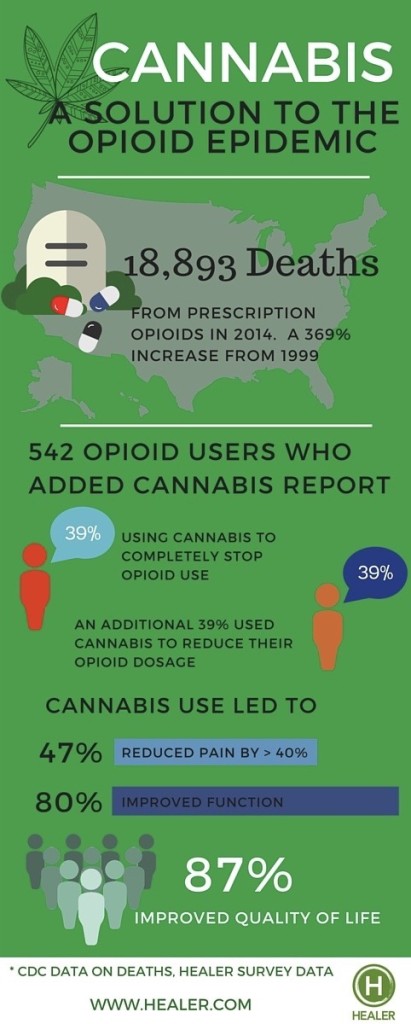
Cannabis and Opioids…..they exist “safely” together.
That’s not a typo. Upon finding the following latest medical research on Cannabis and Opioids, I had to re-read the material at least a dozen times.
Dr. Dustin Sulak, Co-founder Healer.com has worked tirelessly as a medical research pioneer and Physician on establishing Medical Cannabis as a viable, safe option for many health conditions including Chronic Pain.
Among his many Cannabis discoveries; Dr. Sulak’s Cannabis and Opioids medical research has the potential to be the Chronic Pain “paradigm shift” experts have been searching for that offers reliable, dependable, safe and healthy long term Chronic Pain relief.
Below is Dr. Sulak’s Cannabis and Opioid presentation/guide found on his comprehensive website Healer.com.
This guide is provided as an information resource only, and is not to be used or relied on for diagnostic or treatment purposes. This information is not intended to be patient education, does not create any patient-physician relationship, and should not be used as a substitute for professional diagnosis and treatment.Please consult a healthcare provider.

Thousands of people have used cannabis to help them reduce and replace opioidmedications, as demonstrated in numerous recent scientific papers1-4 and strongly supported by animal research.5
I conducted a survey of my patients in 2016. Of the 542 opioid users who added cannabis, 39% were able to completely stop opioid use, and 39% used cannabis to reduce their opioid dosage. Adding cannabis reduced pain by more than 40% in nearly half the patients and improved function in 80%. In 87% of patients, it improved quality of life!
Advantages of Adding Cannabis
• Cannabis enhances pain relief and other medical effects of opioids.5
• Taking cannabis with opioids can make the opioids safer by widening their therapeutic window(the window between the effective dose and the lethal dose). An ineffective dose of an opioid drug can become effective when it’s combined with cannabis.6
- In addition to reducing pain, cannabis conveys holistic benefits, such as improving sleep,7reducing anxiety,8 relaxing muscles, giving perspective on life’s challenges, etc.
- Cannabis relieves the symptoms of opioid withdrawal.9
- In dealing with opioid addiction, cannabis can be safer than other harm reduction options like methadone and Suboxone. It does not have the risk of a fatal overdose and has a lower risk of dependence and problematic use than other psychoactive substances.10 Cannabis can be usedin combination with methadone or Suboxone to enhance the benefits and support a taper ofthese drugs.
- Some studies have shown that cannabis users are more successful adhering to other forms of opioid addiction treatment, such as long-acting naltrexone.9
Basic Principles of Use
- Always use the lowest effective dose of cannabis to avoid building tolerance.(To find your optimum dose, new and experienced cannabis users can follow theHealer.com dosage programs.)
- Even at low doses that do not cause impairment or adverse effects, cannabis can enhance the effects of opioid medications.
- Take a low dose of cannabis with every dose of opioids.
- For longer acting effects, oral delivery, such as a tincture or oil absorbed throughthe blood vessel in the mouth or a capsule swallowed and absorbed in the intestine, is optimal. Both methods allow for a measurable dose in milligrams of THC (tetrahydrocannabinol) and CBD (cannabidiol).
- Only use inhaled cannabis to reduce cravings and for breakthrough symptoms (severepain, flashbacks, panic attacks, withdrawal symptoms, etc.).
- Use cannabis to promote restorative sleep.
- Use cannabis to enhance the enjoyment and benefits of therapeutic activities (exercise,meditation, prayer, journaling, counseling, etc.). (See Healer.com/Wellness for some simple but powerful wellness practices.)
Specific Dosing Information
• I recommend my patients start with a liquid cannabis preparation (tincture or oil) that’s administered under the tongue. This allows for intermediate onset of benefits and easy dosage adjustments. The oral preparation should give a specific milligram (amount ofdrug) per milliliter (amount of liquid) potency (mg/ml), allowing you to accurately dose using drops or an oral syringe.
• The cannabis tincture should be taken 3 to 4 times daily or with every administration of an opioid drug.
• The content of CBD and THC is important. For most of my patients, a CBD:THC ratio ofapproximately 1:1 is broadly effective and well tolerated and may include THCA and CBDA.
> People who are very sensitive to THC can reduce potential unwanted effects by usinga CBD:THC ratio of 4:1 or higher.
> If you don’t have access to cannabis preparations containing CBD, you can still succeed using THC-dominant preparations.
Recommended starting dose: CBD 1 mg + THC 1 mg (may include CBDA and THCA).
- This dose is too low to have a noticeable effect in many patients, but some do report benefits.
- Every day, increase your individual THC dose by 1 to 2 mg (and the appropriate corresponding amount of CBD depending on your selected CBD:THC ratio). If yourDay 1 dose is CBD 1 mg + THC 1 mg (with no discernible effect), on Day 2 increasethe dose to CBD 2 mg + THC 2 mg.
- Most patients achieve good results at 2 to 15 mg of THC per dose.How will I know when I reach my optimal dose?
- Use Healer’s Inner Inventory, located in Healer.com/programs to identify the dose that creates a therapeutic effect (reduced pain, reduced anxiety, etc.).
- If you find that cannabis makes the effects of the opioid feel stronger or last longer, or if you are able to take less of the opioid drugs, you’ve reached an effective dose.
- You can maintain consistent benefits without building tolerance for years or decades if you stay at your optimal dose of cannabis. If you’ve developed tolerance by regularly exceeding your optimal dose, complete Healer’s Sensitization Protocol as soon as possible to recover the full benefits of cannabis.
- You’ve likely exceeded your optimal dose if you experience:
• A reduction in the effects (it was working, but now it’s not).
• An increase in unwanted side effects (such as confusion, lightheadedness,fatigue).
- Many patients find that they are able to decrease their opioid dosage by 50%to 80% in the first 2 weeks after adding cannabis at the optimal dose, and thenthey continue to reduce opioids more slowly thereafter. I encourage you to take advantage of this 2-week window of opportunity. Other people do not experiencethis rapid reduction at first but find they are able to taper their opioid medicationsslowly and consistently.
When using inhaled cannabis for cravings and breakthrough symptoms:
- Use a vaporizer or pipe with cannabis flowers, if possible.
- Take 1 inhalation, wait 5 to 10 minutes, then repeat if necessary.
- Avoid concentrates (hash, dabs, shatter, etc.) and high potency vape pens unless 3 to 5 inhalations of herbal cannabis are ineffective. Concentrates are more likely tocause you to build tolerance to cannabis, and most vape pens fail to convey the fullrange of compounds that produce the desired medical benefits.
- Select cannabis strains that correlate with your specific goals. For example, one strain for sleep, one for pain, one for cravings, etc. See Healer’s Cannabis Shopping Guide for more guidance about strains and their associated benefits.
For Patients New to Cannabis or Not Currently Using Cannabis:
• Refer to Healer’s Introduction to Cannabis program for more specific step-by-step dosing guidance
For Experienced Cannabis Users:
- Before starting to taper opioids, it’s essential that you reverse any tolerance to cannabis to ensure you get best results. I strongly suggest beginning with Healer’s 6-day Sensitization Protocol.
- If you are not experienced with oral dosing of cannabis liquid medicines or capsules,familiarize yourself with this delivery method and find your optimal dosage before starting to taper your opioid drugs. See Healer’s Switching from Inhalation to Tinctureprogram for more details.
If Low-Dose Cannabis Is Ineffective:
- For a small percentage of my patients, low-to-moderate-dose cannabis (≤60mg of THC daily) is notsufficient to help them reduce opioid medications. If you see no response (improved symptomsand ability to decrease opioids) after using cannabis for 30 days at low doses, then it may be time to switch to a high-dose protocol that typically uses cannabis concentrate taken by mouth or high potency edibles.
- Gradually work up to very high doses. For example, start at 20 mg of THC three times daily and gradually, over 1 to 4 weeks, work up to 100 to 500 mg of THC per dose. Gradual titration is important to prevent the unpleasant side effects of cannabis overdose.
CAUTIONS !
1. Discuss your intention to use cannabis for this purpose with your health care provider and collaborate to achieve your goals. Do not adjust the dosage of prescribed opioid medications without discussing it with your provider. If your health care provider is uncomfortable with a THC-positive urine drug screen, please note that the Centers for Disease Control and Prevention (CDC) recommends against urine testing for THC in patients prescribed opioids for chronic pain.11
2. Work with an experienced cannabis clinician who can monitor and provide feedback on your use of cannabis.
3. Inhaled THC-dominant cannabis has rewarding effects that trigger the pleasure centers in thebrain. While this can be useful in combating cravings for more dangerous drugs, it can also trigger a desire for more strongly rewarding substance and behaviors. Please limit your use of inhaled cannabis to cravings and breakthrough symptoms, as described above.
Those who are most successful in using cannabis to replace opioid drugs always use a combination of pharmacologic and behavioral interventions. No medication is powerful enoughto accomplish this goal on its own. By prioritizing and organizing the proper resources for sleep,exercise, counseling, support groups, and social support, you can ensure your success!
References
- 1.Haroutounian S, et al. The effect of medicinal cannabis on pain and quality-of-life outcomes in chronic pain: A prospective open-label study. Clin J Pain.2016;32(12):1036-1043.
- 2.Boehnke KF, Litinas E, Clauw DJ. Medical cannabis use is associated with decreased opiate medication use in a retrospective cross-sectional survey of patients with chronic pain. J Pain. 2016;17(6):739-744.
- 3.Lucas P, Walsh Z. Medical cannabis access, use, and substitution for prescription opioids and other substances: A survey of authorized medical cannabis patients. Int J Drug Policy. 2017;42:30-35.
- 4.Piper BJ, et al. Substitution of medical cannabis for pharmaceutical agents for pain, anxiety, and sleep. J Psychopharmacol. 2017;31(5):569-575.
- 5.Nielsen S, et al. Opioid-sparing effect of cannabinoids: A systematic review and meta-analysis. Neuropsychopharmacology. 2017;42(9):1752.
- 6.Cooper ZD, et al. Impact of co-administration of oxycodone and smoked cannabis on analgesia and abuse liability. Neuropsychopharmacology. 2018:1.
- 7.National Academies of Sciences, Engineering, and Medicine. The Health Effects of Cannabis and Cannabinoids: The Current State of Evidence andRecommendations for Research. Washington, DC: National Academies Press; 2017.
- 8.Walsh Z, et al. Medical cannabis and mental health: A guided systematic review. Clin Psych Rev. 2017;51:15-29.
- 9.Bisaga A, et al. The effects of dronabinol during detoxification and the initiation of treatment with extended release naltrexone. Drug Alcohol Depend.2015;154:38-45.
- 10.Anthony JC, Warner LA, Kessler RC. Comparative epidemiology of dependence on tobacco, alcohol, controlled substances, and inhalants: Basic findingsfrom the National Comorbidity Survey. Exp Clin Psychopharmacol. 1994;2(3):244.
- 11.Dowell D, Haegerich TM, Chou R. CDC guideline for prescribing opioids for chronic pain—United States, 2016. JAMA. 2016;315(15):1624-1645.